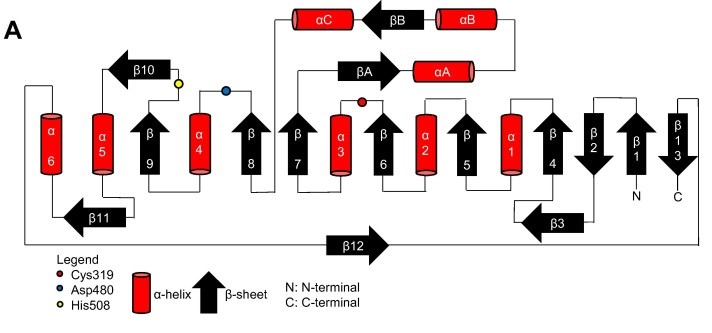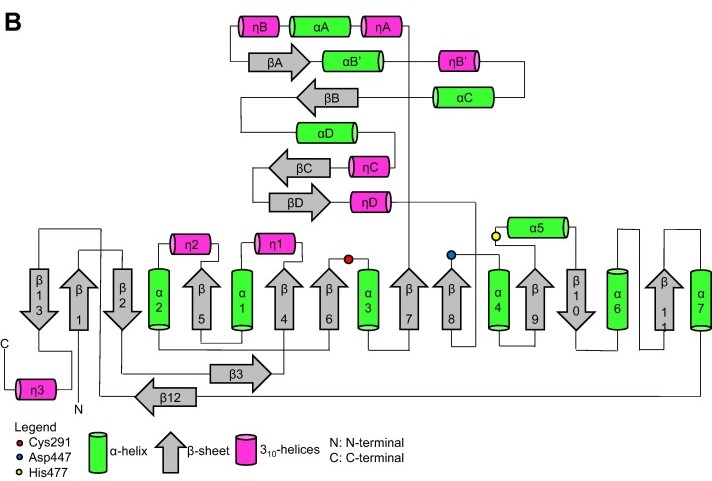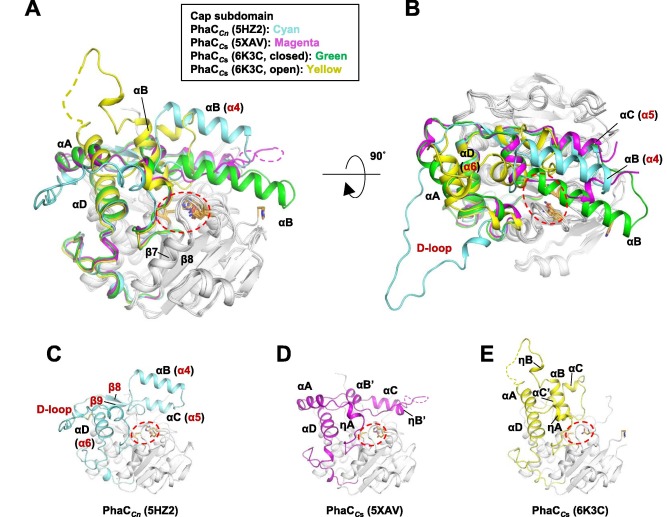User:Gustavo Sartorelli de Carvalho Rego/Sandbox 1
From Proteopedia
(Difference between revisions)
| Line 10: | Line 10: | ||
The class 1 phaCs synthetize preferentially short chain PHAs, with 3 to 5 carbon monomers, and are composed by a single enzymatic unit, with molecular mass ranging from 63 to 73 kDA.<ref name='Neoh' /><ref name='Chek'>Chek, Min Fey, et al. “PHA Synthase (PhaC): Interpreting the Functions of Bioplastic-Producing Enzyme from a Structural Perspective.” Applied Microbiology and Biotechnology, vol. 103, no. 3, 3 Dec. 2018, pp. 1131–1141, https://doi.org/10.1007/s00253-018-9538-8. Accessed 14 May 2023.</ref> | The class 1 phaCs synthetize preferentially short chain PHAs, with 3 to 5 carbon monomers, and are composed by a single enzymatic unit, with molecular mass ranging from 63 to 73 kDA.<ref name='Neoh' /><ref name='Chek'>Chek, Min Fey, et al. “PHA Synthase (PhaC): Interpreting the Functions of Bioplastic-Producing Enzyme from a Structural Perspective.” Applied Microbiology and Biotechnology, vol. 103, no. 3, 3 Dec. 2018, pp. 1131–1141, https://doi.org/10.1007/s00253-018-9538-8. Accessed 14 May 2023.</ref> | ||
| - | Thanks to the X-ray cristallography data from PhaC<sub>cn</sub>-CAT and PhaC<sub>cs</sub>-CAT, it was possible to categorize the class 1 phaCs in based on their molecular organization, made of two domains: The N-terminal domain and the <scene name='10/1050300/Phac_i_catalytic_c_domain/1'>catalytic C-terminal domain</scene>. The C-terminal domain carries the <scene name='10/1050300/Phac_i_catalytic_site/2'>catalytic site, formed by the aminoacid triad (Cys-Asp-His)</ | + | Thanks to the X-ray cristallography data from PhaC<sub>cn</sub>-CAT and PhaC<sub>cs</sub>-CAT, it was possible to categorize the class 1 phaCs in based on their molecular organization, made of two domains: The N-terminal domain and the <scene name='10/1050300/Phac_i_catalytic_c_domain/1'>catalytic C-terminal domain</scene>. <b><span class='text-gray'>The C-terminal domain</span></b> carries the <scene name='10/1050300/Phac_i_catalytic_site/2'>catalytic site, formed by the aminoacid triad</scene> <b><span class='text-red'>(Cys-Asp-His)</span></b> located deep within the <b><span class='text-gray'>hydrophobic</span></b> <scene name='10/1050300/Phac_i_polar/1'>cavity</scene>, that in the closed conformation is partially covered by the <b><span class='text-orange'>Cap</span></b> <scene name='10/1050300/Phac_i_cap_subdomain/1'>subdomain</scene>.<ref name='Neoh' /><ref name='Chek' /> |
=== N-terminal domain === | === N-terminal domain === | ||
| Line 16: | Line 16: | ||
=== C-terminal domain === | === C-terminal domain === | ||
| - | Contrary to the flexible N-terminal domain, the <scene name='10/1050300/Phac_i_catalytic_c_domain/2'>C-terminal domain</scene> is relatively stable, making its crytalization process easier. Because of this, it was possible to obtain the C-terminal domain structure from PhaC<sub>cn</sub>-CAT and PhaC<sub>cs</sub>-CAT through X-ray cristallography, with resolution of 1.8 Å and 1.48 Å, respectively. The C-terminal domain has the <scene name='10/1050300/Phac_i_catalytic_site/2'>catalytic site, with the aminoacid triad (Cys-Asp-His)</ | + | Contrary to the flexible N-terminal domain, the <scene name='10/1050300/Phac_i_catalytic_c_domain/2'>C-terminal domain</scene> is relatively stable, making its crytalization process easier. Because of this, it was possible to obtain the <b><span class='text-gray'>C-terminal domain</span></b> structure from PhaC<sub>cn</sub>-CAT and PhaC<sub>cs</sub>-CAT through X-ray cristallography, with resolution of 1.8 Å and 1.48 Å, respectively. The C-terminal domain has the <scene name='10/1050300/Phac_i_catalytic_site/2'>catalytic site, with the aminoacid triad</scene> <b><span class='text-red'>(Cys-Asp-His)</span></b>, the substrate entrance and the product egress tunnel.<ref name='Neoh' /> |
| - | The overall form of a phaC protein is that of a typical protein from the α/β-hydrolase-fold, with the C-terminal domain made of an <scene name='10/1050300/Phac_i_catalytic_hydrolase_sub/1'>α/β-hydrolase core subdomain</scene> and a <scene name='10/1050300/Phac_i_catalytic_cap_sub/1'> | + | The overall form of a phaC protein is that of a typical protein from the α/β-hydrolase-fold, with the C-terminal domain made of an <scene name='10/1050300/Phac_i_catalytic_hydrolase_sub/1'>α/β-hydrolase core subdomain</scene> and a <b><span class='text-orange'>Cap</span></b> <scene name='10/1050300/Phac_i_catalytic_cap_sub/1'>subdomain</scene>, corresponding to the Thr347-Pro471 residues in PhaC<sub>cn</sub>, and Thr319-Pro438 residues in PhaC<sub>cs</sub>. It is in the α/β-hydrolase subdomain that the entrance tunnel, the catalytic site and the product egress tunnel are located. This region seems to be preserved in phaCs.<ref name='Neoh' /> |
| - | Regarding the <scene name='10/1050300/Phac_i_catalytic_cap_sub/1'> | + | Regarding the <b><span class='text-orange'>Cap</span></b> <scene name='10/1050300/Phac_i_catalytic_cap_sub/1'>subdomain</scene>, the LID region is extremely dynamic and flexible, having an open or closed conformation based on structural changes. Because of this, the Cap subdomain, specially the LID region, is not as conserverd in the phaCs as the α/β-hydrolase subdomain. The Cap subdomain is located after the β7 sheet, and connects with the β8 sheet from the α/β-hydrolase core. In PhaC<sub>cn</sub>, the Cap subdomain is formed by three α-helixes (α4, α5 and α6) and two β-sheets (β8 and β9). Meanwhile, PhaC<sub>cs</sub> has six α-helixes (αA, αB, αC, αD, ηA and ηB').<ref name='Neoh' /> |
The cristallography of PhaC<sub>cs</sub>-CAT bound to its substrate revealed the complex assymetric dimer structure of this enzyme. The phaC dimer form can be induced by the presence the substrate. Due to the dynamic and flexible properties, specially of the LID region, the Cap subdomain is paramount in the phaC dimer formation and regulation of substrate entry and product release, since it determines the protomer's movements, regulating the change between the closed form - homodimer- and the open form - heterodimer. <ref name='Neoh' /> | The cristallography of PhaC<sub>cs</sub>-CAT bound to its substrate revealed the complex assymetric dimer structure of this enzyme. The phaC dimer form can be induced by the presence the substrate. Due to the dynamic and flexible properties, specially of the LID region, the Cap subdomain is paramount in the phaC dimer formation and regulation of substrate entry and product release, since it determines the protomer's movements, regulating the change between the closed form - homodimer- and the open form - heterodimer. <ref name='Neoh' /> | ||
Revision as of 18:31, 2 June 2024
Introduction
| |||||||||||



